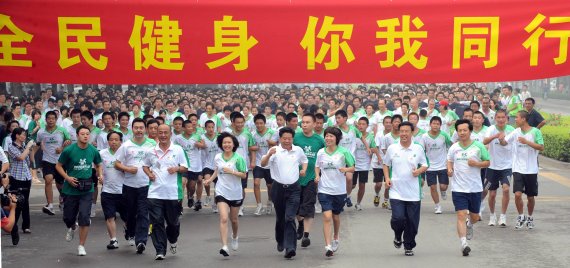
Running isn’t just something for your health in China, it’s also good for your lifestyle and status. Because you have to be able to afford sports in general. It’s not just a question of acquisition costs for sports equipment, but also of the time you have to invest.
The growing middle class (now numbering over 100 million Chinese) in particular now has the time and the necessary pocket change for running shoes and other items. According to Nielsen Sport, these runners have above-average education, usually with at least a college degree.
Running is the most important sport for (hobby) athletes in China, ahead of fitness, badminton, and swimming. Five million Chinese participated in one running event alone in 2017. “But running still has a lot more potential for growth in China,” says Robin Trebbe, Intersport Managing Director China & Asia Pacific.
According to a statistic by China Daily, there will be 1,900 running competitions with ten million participants in 2020, twice the amount of 2017.
These figures are naturally interesting for every running and fitness company. Already in 2017, sales for running products in China amounted to 6.3 billion dollars and had a growth rate of 25 percent compared to the previous year.
And, of course, runners’ interest in articles for their sport doesn’t stop with running shoes and clothes - a point that Trebbe also emphasizes. “Activity trackers, special MP3 players for runners, headlamps, and many other articles are interesting for runners,” says the Asian region sports expert.
Added to that are completely new sales and service offerings, like foot scans or new apps and wearables – also as a result of digitization. For companies with niche products in the running segment especially, China is one of the most interesting markets.
Trebbe estimates that 15 percent of overall revenue in the Chinese sports market is made with running products.
And running in and of itself continues to evolve: The popularity of trail running continues to climb and tap new target groups. At the same time, companies in China are meeting a “discerning, quality-conscious group of buyers,” says Trebbe. An opportunity for well-known Western brands, generally very popular in China because they stand for reliability and high value.
The big brands have already been benefitting from this for some time: Flagship stores by Adidas and Nike are no longer just popular shopping destinations in cities like Shanghai or Beijing. Nike, for example, generated a total of 5.1 billion dollars in the greater Chinese area in the 2017/18 fiscal year - one-seventh of the manufacturer’s global sales ($36.3 billion).
Next to the lifestyle segment, the running segment is likely to have been one of the most important revenue drivers. With events and its own community offerings, the manufacturer is trying to get runners excited for its brand.
Competitor Adidas even opened its first running flagship store worldwide in Chengdu, China in 2016. Shanghai has had a RunBase with an outdoor track and treadmills in the middle of the city since 2015.
- Awards
- Mountain sports
- Bike
- Fitness
- Health
- ISPO Munich
- Running
- Brands
- Sustainability
- Olympia
- OutDoor
- Promotion
- Sports Business
- Textrends
- Triathlon
- Water sports
- Winter sports
- eSports
- SportsTech
- OutDoor by ISPO
- Heroes
- Transformation
- Sport Fashion
- Urban Culture
- Challenges of a CEO
- Trade fairs
- Sports
- Find the Balance
- Product reviews
- Newsletter Exclusive Area
- Magazine






